Tannhäuser is probably the most human hero among all the figures created by Wagner, who cannot escape the carnal lust (Venus), although he strives for spirituality (Elisabeth). Wagner himself has described that his “inclination to sensual impetuosity” is in conflict with the “seriousness of artistic feeling”.
The hall aria – Elisabeth awaits excited Tannhäuser
In the Wartburg Castle. Elisabeth, the niece of the landgrave, is happy about the return of Tannhäuser. She is in the hall which she has not entered since Tannhäuser had left.
This aria is also known as the “hall aria”. Formally, it stands on the middle ground between the Grand Opéra and musical drama. Thus, Tannhäuser still has various self-contained, effective musical pieces such as the hall aria. Vibrating horns create an electrified atmosphere. Elisabeth has every reason to be excited. Joyfully excited, Elisabeth begins the aria. At the thought of Tannhäuser’s departure, the music changes to gloom. An oboe brings Elisabeth back into the jubilant mood of the beginning. With a repeated increase of the “sei mir gegrüsst” (“I greet thee”) in pitch and tone strength Wagner leads Elisabeth to a climactic D.
We hear this aria first in the interpretation by Elisabeth Grümmer. Grümmer was a singer who had soul in her voice. The German music critic Joachim Kaiser wrote about her recording: How Elisabeth Grümmer sings Elisabeth with heart-moving intimacy, completely un-kitsched but so tenderly glowing, that one can speak of an ideal cast.
Dich teure Halle – Grümmer
The famous pilgrim choir
Beglückt, darf nun dich, o Heimat, ich schauen
Tannhäuser’s Roman Tale
Wolfram meets the exhausted Tannhäuser, who looks for the way to the Venusberg. He tells Wolfram about his trip to Rome. Although he surpassed everyone by repentance, he found no forgiveness from the Pope, whose words were: just as the pilgrim staff will no longer bedecked with green, so your salvation rests impossible for me.
Tannhäuser stands most of the time on stage . Now towards the end the tenor faces the great “pièce de résistance”, the 10-minute-long Roman Tale, in which the tenor has to mobilize the last reserves of strength.
Lauritz Melchior was possibly the greatest Wagner tenor of all time. The “great Dane”, as Cosima called him, was an elemental force. He claimed of himself that he could easily sing Tristan 2 times in the evening. He was a master of expression with pathos, so Roman Tale was masterful.
Inbrunst im Herzen (1) – Lauritz Melchior







Leave a Reply
Want to join the discussion?Feel free to contribute!